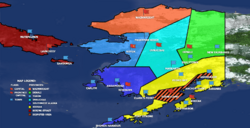Alaskan Empire Province (Nova): Difference between revisions
robertparr (talk | contribs) (Edited the side panel thing, nto finished yet though) |
robertparr (talk | contribs) m (Edited the side panel.) |
||
| Line 6: | Line 6: | ||
|image2=Example | |image2=Example | ||
|image3=Example | |image3=Example | ||
|formed= | |formed= | ||
|largest_city= | |largest_city= | ||
|region=North America | |region=North America | ||
|political_system=Province government | |political_system=Province government | ||
|leader1name= | |leader1name=karlraven26 | ||
| | |leader1=Emperor | ||
|executive=Example | |executive=Example | ||
|legislature=Example | |legislature=Example | ||
|economic_system=[[file:Gold Icon.png|30px]] Capitalism | |economic_system=[[file:Gold Icon.png|30px]] Capitalism | ||
|part_of=Alaskan Empire | |part_of=Alaskan Empire | ||
}} | }} | ||
In the [[Alaskan Empire (Nova)|Alaskan Empire]], a '''province''' was a constituent political entity, of which there were six. Bound together in a political union, each province held governmental jurisdiction over a separate and defined geographic territory where it shared its sovereignty with the feudal government. Due to this shared sovereignty, Alaskans were citizens both of the Empire and of the province in which they resided. Province citizenship and residency are flexible, and no government approval was required to move between provinces. | In the [[Alaskan Empire (Nova)|Alaskan Empire]], a '''province''' was a constituent political entity, of which there were six. Bound together in a political union, each province held governmental jurisdiction over a separate and defined geographic territory where it shared its sovereignty with the feudal government. Due to this shared sovereignty, Alaskans were citizens both of the Empire and of the province in which they resided. Province citizenship and residency are flexible, and no government approval was required to move between provinces. | ||
| Line 43: | Line 23: | ||
Generally, town borders throughout the Empire were not limited by provincial borders, and no effort was made to ensure that the province borders matched the town borders. On top of this, construction projects often crossed province borders without any repercussions. | Generally, town borders throughout the Empire were not limited by provincial borders, and no effort was made to ensure that the province borders matched the town borders. On top of this, construction projects often crossed province borders without any repercussions. | ||
==List== | ==List == | ||
Revision as of 17:53, 7 February 2023
In the Alaskan Empire, a province was a constituent political entity, of which there were six. Bound together in a political union, each province held governmental jurisdiction over a separate and defined geographic territory where it shared its sovereignty with the feudal government. Due to this shared sovereignty, Alaskans were citizens both of the Empire and of the province in which they resided. Province citizenship and residency are flexible, and no government approval was required to move between provinces.
Province leaders in Alaska were given power directly by the Emperor. Provinces and their leaders possessed many powers and rights in the Alaskan council. Citizens and their needs were expected to be represented by their respective province leaders.
Generally, town borders throughout the Empire were not limited by provincial borders, and no effort was made to ensure that the province borders matched the town borders. On top of this, construction projects often crossed province borders without any repercussions.
